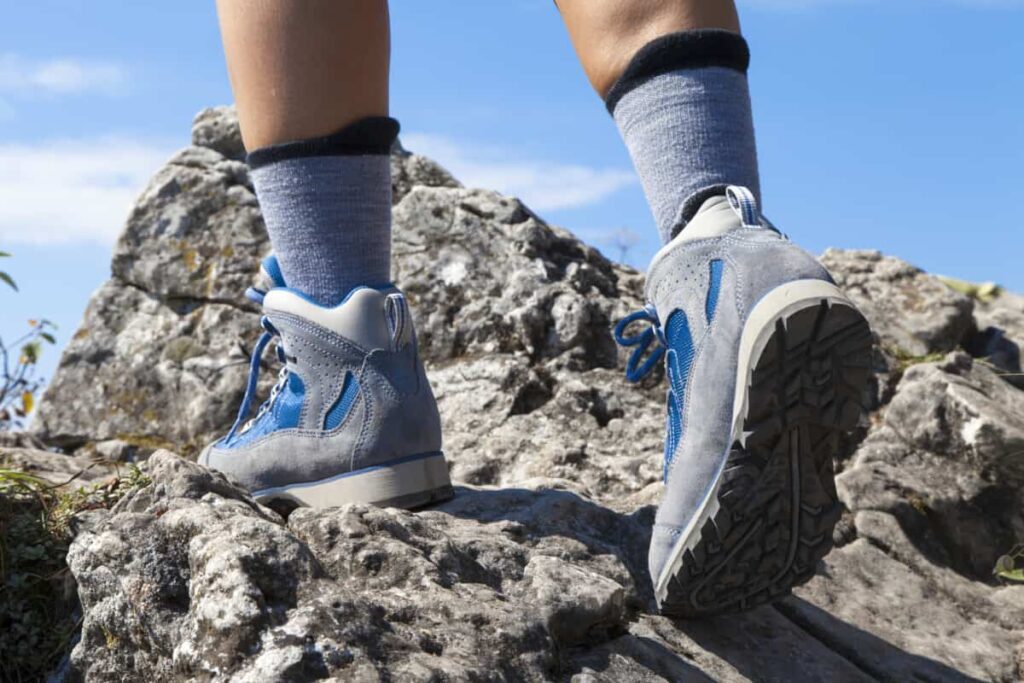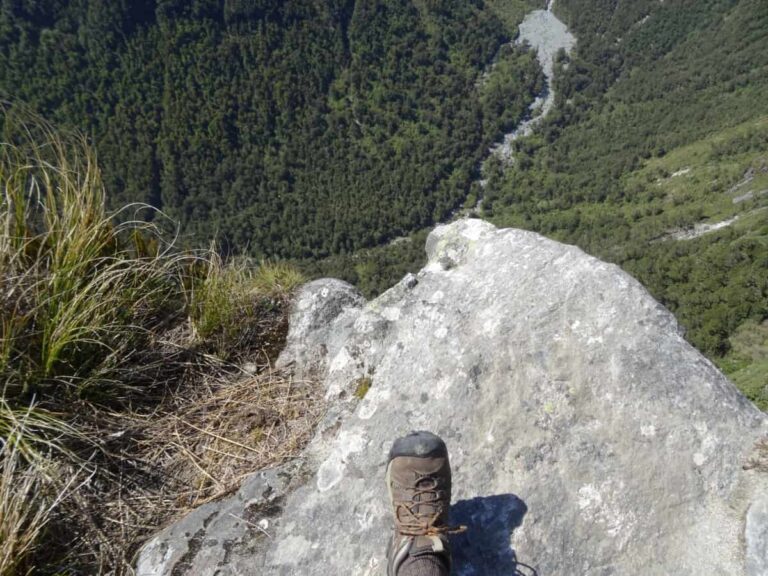What Material Is Best For Hiking Socks?
Will your typical socks do the trick, or are there better socks to hike in?
The best materials for hiking socks include wool in combination with synthetic materials like Polyester and Spandex. These materials work together to provide efficient thermoregulation while adding durability and flexibility. Consequently, hiking socks made from these materials last longer and are considered to be more comfortable in a wide variety of environmental conditions.
The right gear can make or break your hiking experience. Most of us are well aware that a suitable outfit, hiking stick, and emergency supplies can play a huge role in your journey. However, not as many of us think about how important our socks are on a hike.
Truthfully, socks are just as much of a tool as anything else you’d bring or wear on a hike. There are a variety of different kinds, from thermoregulation wool socks to water-resistant Neoprene. Because of all the options out there, it can be tough to tell what kind of hiking sock is best. Although the answer to that question might depend on what kind of hiking you plan on doing, it’s also possible to find sock materials that are suitable for a wide variety of purposes. I’ve done the research to help you gear up with the right socks to make sure your feet are as comfortable as possible for any hike.

Which Is The Best Material For Hiking Socks?
If you’re new to the hiking hobby, you may not even be aware that there are better socks out there than what you wear day-to-day. However, hiking is an activity that can take quite a toll on your feet if you aren’t careful! Wearing the right socks can cut down on friction-related injuries, misery, and moisture.
Best For Thermoregulation – Merino Wool
Merino wool is a special kind of wool that comes from Merino sheep. When compared to other types of wool, Merino provides the wearer with efficient thermoregulation and padding with less bulk. As a result, there’s less of a chance it will disrupt the fit of your hiking footwear. Brands like Smartwool make use of Merino wool in their hiking socks.
Merino wool is especially useful in rainy weather. Take a look at our article here for more tips on what to wear when you’re planning a hike in the rain.
Best For Wet Conditions – Neoprene
Made from the same materials as wetsuits, Neoprene socks are ideal in any situation where you expect your feet might get wet. Typically, these socks are best when you’re trying to protect your feet from water coming in from the outside, like when you need to cross a stream. You can find Neoprene socks from brands such as Seavenger and Akona.
If you’re interested in looking into more of the top Neoprene sock brands, you’ll find everything you need to know in our article on the topic here.
Best Overall – Synthetic
There’s no denying that wool is where it’s at, especially when combined with materials that make your socks more durable and efficient. It’s great for thermoregulation and moisture-wicking, allowing your feet to remain dry and comfortable. What you will want to keep in mind is how thick your socks are. Some kinds of wool are bulkier than others, meaning they may not be as efficient in warmer weather. Aim for thinner wool socks if you plan on hiking in the heat.
Most Popular Hiking Sock Materials
It can be both a blessing and a curse that there are so many different kinds of hiking socks to choose from. Variety is great when you need to find just the right hiking sock for your journey, but it can also be overwhelming to try and pick what you need.
You can make this a bit simpler without getting lost in the details by taking a look at what hiking sock materials are most popular. Often, there are some pretty solid reasons why people tend to choose certain materials over others. Let’s take a look at a few of the most popular hiking sock materials.
Wool
Wool is a popular material for just about any clothing item you might wear while hiking. It honestly goes to show that nature really knows how to create efficient materials. When many people think about wool, they imagine warmth. However, it’s actually well-suited for a variety of temperatures.
The ability to wick away sweat makes wool a great ally in warmer conditions. Additionally, wool provides the wearer with thermoregulation – meaning it assists in either warming or cooling depending on the environment. For those who opt for wool socks, the results are comfortable feet free from excess sweat and blisters.

Aside from temperature and moisture regulation, wool socks are also capable of providing a greater amount of cushioning and insulation.
I actually asked hikers which type of sock they wore when hiking and the most popular choice (about 1/3rd) chose Darn Tough (Amazon), specifically and many others used some other wool blend such as Smartwool.
Neoprene
For those who are unfamiliar with Neoprene, this material is what is typically for wetsuits. Neoprene allows the person using the wetsuit to spend time in cold, wet conditions without too much discomfort. As a result, this material can also be useful for making socks.
As you might expect, Neoprene socks are best suited for wet conditions. You’re unlikely to need them for most shorter hikes, but they’re extremely useful during activities like kayaking, backpacking, and hiking in wet conditions. Furthermore, combining Neoprene socks with another pair of socks can keep friction at bay when you’re doing high-intensity hikes.
In any situation where excess friction or moisture might become a problem, it never hurts to bring along a pair of Neoprene socks to try out.
Synthetics (Nylon, Polyester, Blends)
The most popular hiking socks you’ll find on the market are typically made up of synthetic blends. Top brands like Darn Tough don’t just include wool, but also make use of Nylon and Spandex as well. Combining materials results in a pair of socks that are more comfortable, reliable, and durable. They last longer and stand a much stronger chance of keeping your feet happy while you’re navigating a trail.
Adding Spandex to socks keeps them from stretching out and becoming formless. Meanwhile, Nylon increases the lifespan of the materials by making them less prone to damage. In some cases, Polyester may even be added in order to boost the level of insulation and moisture-wicking capabilities that the socks provide.
Thin Or Thick Socks For Hiking?
It’s easy to see how both thin and thick hiking socks can be useful. Thick socks provide more warmth and padding but may make the inside of your shoes a bit too stuffy and cramped. Thin socks won’t take up as much space, but they won’t give you the warmth you need during the cooler seasons. In order to determine which is best, it’s a good idea to think about what benefits and downfalls each option provides.
Thin Hiking Socks
Thinner hiking socks are designed to keep your feet cool and dry. Because of that, they’re best used in warmer conditions. The breathability they offer is ideal for cooling off but may cause your feet to become too cold in moderate or cold conditions. That said, thinner socks can be combined with thicker socks for added cushioning and warmth.

You can use thin socks as a sock liner. Some people ask if you can wear two pairs of socks when hiking–I go into much more detail about this in my article, here.
Advantages
- Breathable.
- Moisture-wicking.
- You can always use thin socks as sock liners.
- Comfortable in warmer temperatures.
Disadvantages
- Less padding.
- Not suitable for cooler temperatures.
Thick Hiking Socks
Thick hiking socks prioritize cushioning and warmth. They’re perfect for cold, wet environments when you need to protect your feet. Because they have more cushion, thicker hiking socks can be considered more comfortable, but they might get too warm if temperatures rise. However, there is a spectrum of thicker socks that can allow you to balance out the warmth and cushioning provided to suit your needs.
Advantages
- More cushioning.
- Added warmth.
- Keep feet dry.
- Durability.
Disadvantages
- May easily become too warm.
- Thickness may change the way your shoes fit.
The Verdict
Truthfully, both thinner and thicker socks have a place in a hiker’s wardrobe. Depending on weather conditions and the length of your hike, you may find that you need to switch between the two multiple times. Ideally, it’s best to bring both kinds of socks with you whenever a hike goes beyond a couple of hours.
For both, you’ll also want to test how well they fit with your hiking shoes or boots. It’s possible to find that thin socks fit perfectly with the footwear you already have, but thick socks leave things too crowded.

If you go to REI you can find lots of hiking footwear to try on–you can use this opportunity to test out your hiking socks.
The good news is that there is a wide range of thicknesses available when it comes to hiking socks. With a little effort, you’ll be able to find the right socks for a comfortable hike. Although the added time and expense might not be the most appealing, it’s really worth it to avoid having uncomfortable feet during a hike. Foot pain, sweatiness, and cold toes can really disrupt things when you’re out in nature.
Which Sock Material Lasts Longest?
Although it isn’t always considered the most comfortable or effective material to use for socks, Polyester is often included in many sock blends. This is due to the material being so durable. In my research, I found that most resources will include Polyester socks for almost every occasion for which you might wear socks.
Polyester increases the durability and abrasion of materials it’s blended with. This has actually been tested in a lab. (source)
That said, Polyester is often combined with other materials because it doesn’t have the insulation and other properties of wool or whatever benefits the material it’s being blended with.
Are Cotton Or Wool Socks Better For Hiking?
Throughout history, cotton has proven itself to be an incredibly useful material. It’s soft, reasonably durable, and highly comfortable. Because of this, it also tends to make for a great material for socks. In fact, the majority of the socks we buy are made with cotton as well as materials like Spandex. On any typical day, cotton socks are perfectly suitable to wear from dawn until dusk.
However, there are instances in which cotton may not be the best choice. This includes any hiking trip that goes on beyond an hour or two. In these situations, your feet will likely need more padding and temperature control. The socks you find at Walmart are often not padded in the same way hiking socks are.
Wool is far more capable of providing the extra care that will keep your feet from becoming too hot, too cold, or too damp. It’s also a great material for avoiding blisters and sore spots that result from additional friction.
Cotton socks will soak up moisture. While that in itself can be a benefit, cotton has a tendency to hold onto moisture. That means that unless you take the time to run them through a dryer or at least hang them up to dry out, they’re likely to stay damp.
Cotton clothing in general can be problematic under many hiking conditions. Cotton is one of those things that many people will say you absolutely should not wear, and I disagree. Cotton isn’t optimal for cold wet conditions, but if you’re hiking in the summertime, it doesn’t really make a huge difference. You can read more about cotton as activewear here.
Whether that dampness is from sweat, puddles, or walking through a stream, it’s likely to stay with you well after the fact. In situations where sweat is the culprit, this can also lead to your feet feeling cold and clammy while you’re cooling down.
Additionally, damp socks increase the risk of friction, leaving hot spots and blisters on your skin. Considering all the alternatives out there, cotton socks just aren’t ideal when you intend on really getting into your hike. However, they aren’t likely to cause too much of a problem during shorter hikes. Just make sure to change into some clean, dry socks once the hike is over.
Generally speaking, your feet will be much happier if you choose wool-based socks when hiking for longer periods of time or in cold, wet weather.
Hiking Without Socks
I’m not going to lie – there are few things worse than the feeling of wet socks. If you also can’t stand getting your socks wet, you might be left wondering whether or not it’s even worth wearing them. You never know when you might end up with wet feet. Whether it’s the result of an unexpected rainfall or due to your own sweat, moisture is likely to be present. Without socks, you can avoid that wet sock feeling and allow your feet to dry more quickly if they do end up getting wet.
It’s a promising idea, but going sockless in hiking shoes or boots really isn’t recommended. At the very least, going without socks is a good way to end up with smelly shoes. It can also make you more prone to fungal infections, hot spots, blisters, and other injuries due to friction. Socks are meant to protect you from all of these issues – especially while hiking.
For those who want to avoid wet socks as much as possible, bringing along a pair of Crocs or sandals can be a great idea. Although these shoes aren’t great for hiking, they can be great in situations where you have to walk through water in order to reach your destination. We talk a lot more about Crocs as water shoes in this article, here.
Change into your preferred water shoes when you reach a crossing, and make sure your feet are completely dry prior to putting your socks and hiking shoes back on.





